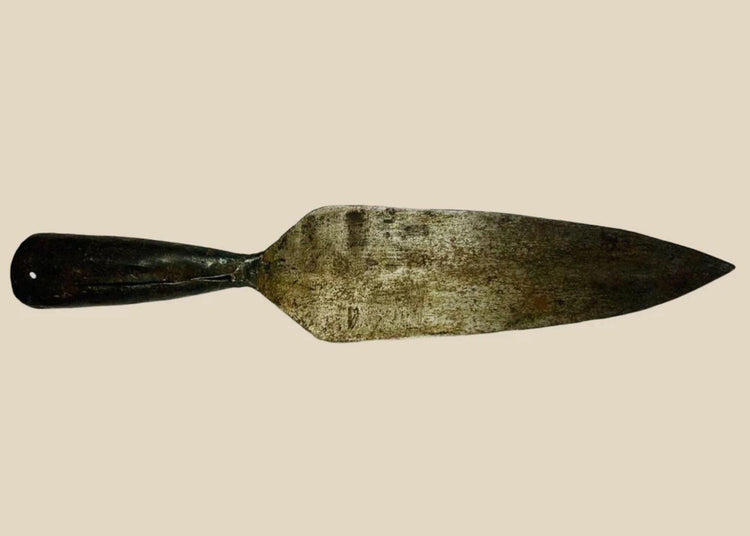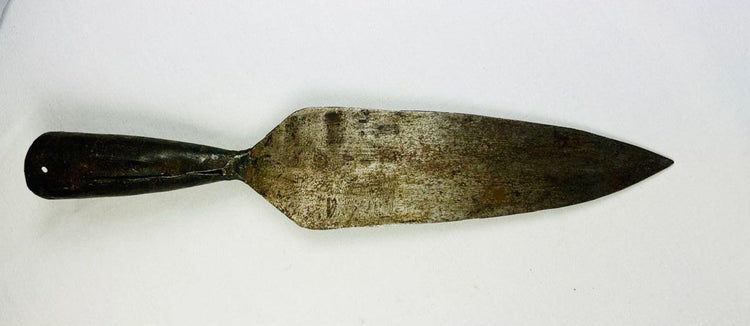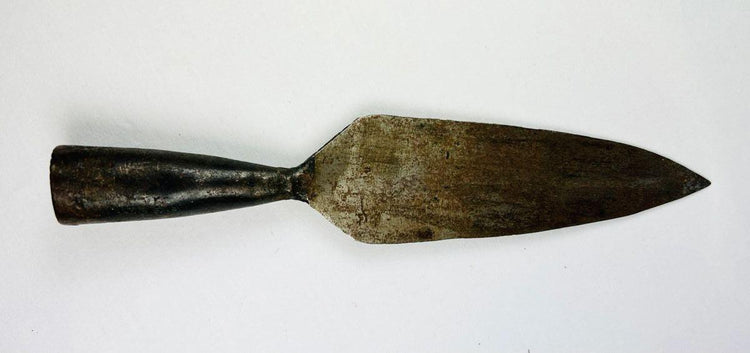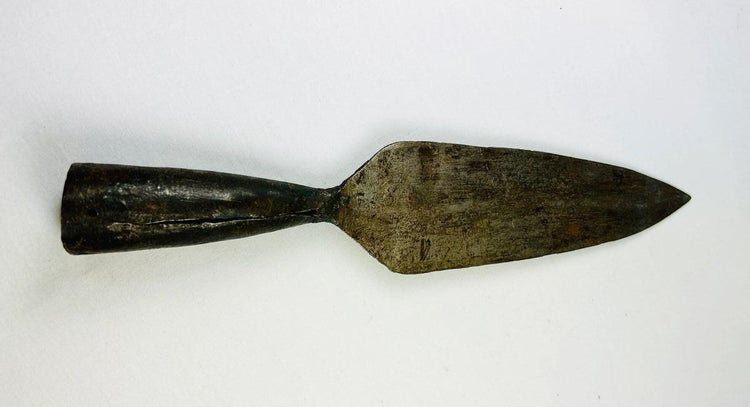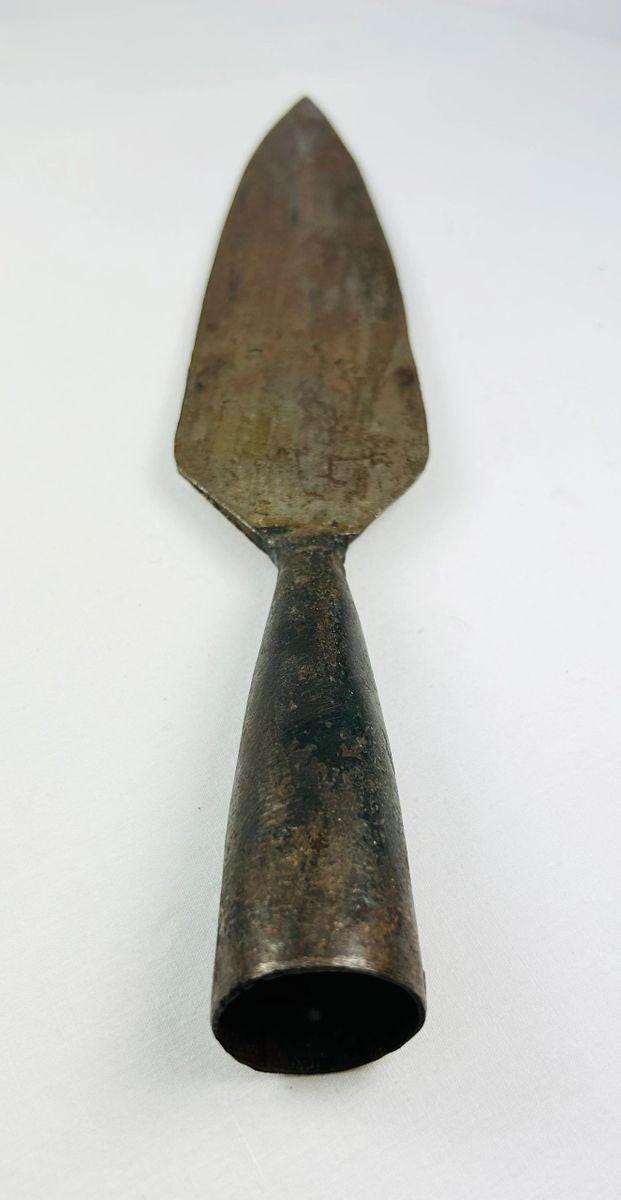Indo-Persian Iron Spearhead | Leaf-Bladed Polearm Tip with Socket | Circa 1700s
Description
More
Less
Historical Context & Origin
Region: Indo-Persian (likely India or Persia)
Material: Forged iron
Period: 18th Century
Description
This Indo-Persian iron spearhead represents the refined military craftsmanship of the 18th century, a time when both India and Persia excelled in metallurgy and weaponry. Forged with a broad, leaf-shaped blade, it combines practical combat design with aesthetic symmetry, reflecting both functionality and ceremonial significance. The slightly convex surface of the blade enhances aerodynamic efficiency, while the tapered socket would have allowed for secure mounting on a wooden shaft. Such spearheads were vital tools of war but also symbols of honor and divine favor, often associated with the warrior elite and royal guards of the Indo-Persian world.
Features
- Broad, leaf-shaped blade with symmetrical edges
- Slightly convex design for aerodynamic balance and cutting efficiency
- Tapered socket for secure attachment to a wooden shaft
- Retains authentic aged patina with surface wear from centuries of use
- Represents both military functionality and ceremonial symbolism
Cultural Significance
Weapons in the Indo-Persian tradition carried layered meaning—used not only on the battlefield but also as emblems of power, status, and spiritual protection. A spearhead of this quality would have belonged to a warrior or noble retainer, functioning as both a practical armament and a statement of prestige. In ceremonial contexts, such pieces could represent divine authority and the embodiment of martial virtue.
Condition
The spearhead displays a rich, naturally aged patina with light surface corrosion consistent with centuries of age. Despite its antiquity, the blade remains structurally sound, and the socket retains its original form, confirming its functional authenticity. The wear patterns enhance its character, underscoring its historical use and significance.
Dimensions (approximate)
Length: 9.25 in
Age
Over 200 years old
Learn More
Uncover the legacy and artistry of Indo-Persian culture—step into the world that forged weapons like this.
Discover when the very first spearheads appeared — the surprising origins of humanity’s oldest weapon.
Description
Historical Context & Origin
Region: Indo-Persian (likely India or Persia)
Material: Forged iron
Period: 18th Century
Description
This Indo-Persian iron spearhead represents the refined military craftsmanship of the 18th century, a time when both India and Persia excelled in metallurgy and weaponry. Forged with a broad, leaf-shaped blade, it combines practical combat design with aesthetic symmetry, reflecting both functionality and ceremonial significance. The slightly convex surface of the blade enhances aerodynamic efficiency, while the tapered socket would have allowed for secure mounting on a wooden shaft. Such spearheads were vital tools of war but also symbols of honor and divine favor, often associated with the warrior elite and royal guards of the Indo-Persian world.
Features
- Broad, leaf-shaped blade with symmetrical edges
- Slightly convex design for aerodynamic balance and cutting efficiency
- Tapered socket for secure attachment to a wooden shaft
- Retains authentic aged patina with surface wear from centuries of use
- Represents both military functionality and ceremonial symbolism
Cultural Significance
Weapons in the Indo-Persian tradition carried layered meaning—used not only on the battlefield but also as emblems of power, status, and spiritual protection. A spearhead of this quality would have belonged to a warrior or noble retainer, functioning as both a practical armament and a statement of prestige. In ceremonial contexts, such pieces could represent divine authority and the embodiment of martial virtue.
Condition
The spearhead displays a rich, naturally aged patina with light surface corrosion consistent with centuries of age. Despite its antiquity, the blade remains structurally sound, and the socket retains its original form, confirming its functional authenticity. The wear patterns enhance its character, underscoring its historical use and significance.
Dimensions (approximate)
Length: 9.25 in
Age
Over 200 years old
Learn More
Uncover the legacy and artistry of Indo-Persian culture—step into the world that forged weapons like this.
Discover when the very first spearheads appeared — the surprising origins of humanity’s oldest weapon.
You May Also Like
















